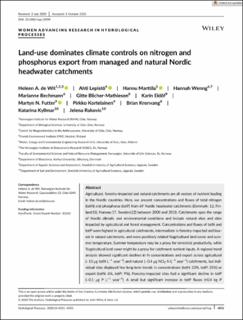| dc.description.abstract | Agricultural, forestry‐impacted and natural catchments are all vectors of nutrient loading in the Nordic countries. Here, we present concentrations and fluxes of total nitrogen (totN) and phosphorus (totP) from 69 Nordic headwater catchments (Denmark: 12, Finland:18, Norway:17, Sweden:22) between 2000 and 2018. Catchments span the range of Nordic climatic and environmental conditions and include natural sites and sites impacted by agricultural and forest management. Concentrations and fluxes of totN and totP were highest in agricultural catchments, intermediate in forestry‐impacted and lowest in natural catchments, and were positively related %agricultural land cover and summer temperature. Summer temperature may be a proxy for terrestrial productivity, while %agricultural land cover might be a proxy for catchment nutrient inputs. A regional trend analysis showed significant declines in N concentrations and export across agricultural (−15 μg totN L−1 year−1) and natural (−0.4 μg NO3‐N L−1 year−1) catchments, but individual sites displayed few long‐term trends in concentrations (totN: 22%, totP: 25%) or export (totN: 6%, totP: 9%). Forestry‐impacted sites had a significant decline in totP (−0.1 μg P L−1 year−1). A small but significant increase in totP fluxes (+0.4 kg P km−2 year−1) from agricultural catchments was found, and countries showed contrasting patterns. Trends in annual concentrations and fluxes of totP and totN could not be explained in a straightforward way by changes in runoff or climate. Explanations for the totN decline include national mitigation measures in agriculture international policy to reduced air pollution and, possibly, large‐scale increases in forest growth. Mitigation to reduce phosphorus appears to be more challenging than for nitrogen. If the green shift entails intensification of agricultural and forest production, new challenges for protection of water quality will emerge possible exacerbated by climate change. Further analysis of headwater totN and totP export should include seasonal trends, aquatic nutrient species and a focus on catchment nutrient inputs. | |
